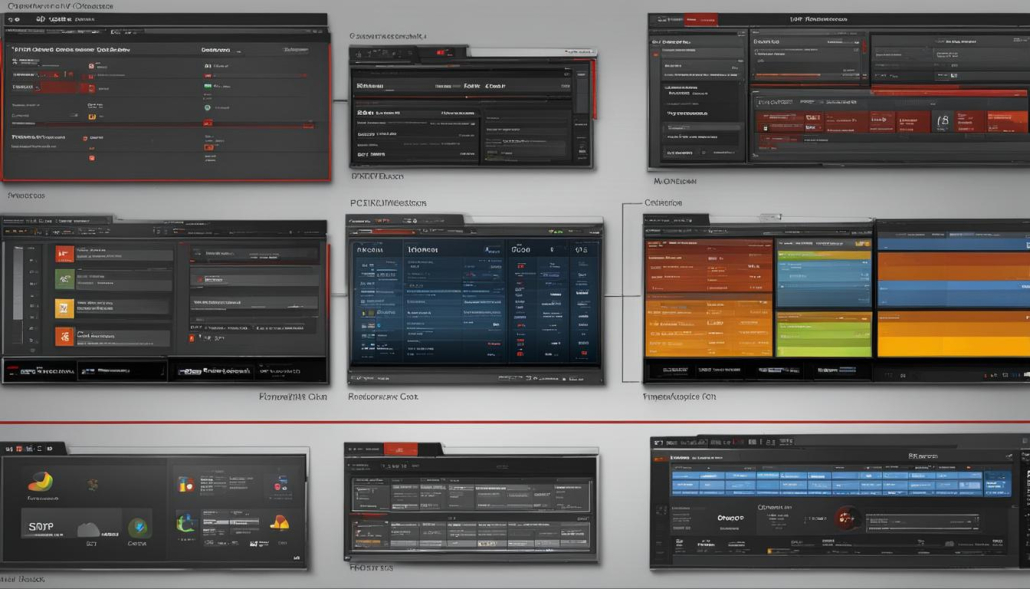Comparing Solutions: pfSense vs. OPNsense – Which is Best?
Welcome to our comprehensive comparison of two popular open-source firewalls – pfSense and OPNsense. In this article, we will delve into the key features and differences between these network security appliances, helping you make an informed decision for your organization’s needs.
Open-source firewalls have gained significant popularity due to their flexibility, cost-effectiveness, and robust security. Both pfSense and OPNsense offer a wide range of features and capabilities, making them top choices for organizations seeking reliable network security solutions.
Key Takeaways:
- pfSense and OPNsense are open-source firewalls widely used for network security.
- pfSense is known for its stability, user-friendly interface, and strong community support.
- OPNsense aims to provide a more modern and secure alternative to pfSense, with a focus on user-friendly experience and code quality.
- Both firewalls offer key features such as a stateful firewall, VPN support, and reporting tools.
- The choice between pfSense and OPNsense depends on individual preferences, feature requirements, and ease of use.
What is pfSense?
pfSense is a free, open-source firewall and router software based on FreeBSD. It is a powerful network security solution that offers advanced features and high levels of customization. As an open-source platform, pfSense allows users to tailor their firewall and router configurations to meet their specific needs.
With pfSense, you can use it as a simple firewall or take advantage of its extensive capabilities to create VLANs, install packages, and set up VPNs. Its stability and user-friendly interface make it a popular choice for individuals and organizations looking to enhance their network security.
As an open-source project, pfSense benefits from a strong community support, with a large and active user base. This community-driven nature ensures regular software updates and enhancements, as well as access to a wealth of resources and knowledge. Whether you’re a network administrator, IT professional, or a tech-savvy individual, pfSense offers a reliable and flexible solution for safeguarding your network.
| Key Features of pfSense |
|---|
| Stateful firewall with network connection tracking |
| Traffic shaping for bandwidth allocation |
| Support for various VPN protocols like IPsec and OpenVPN |
| DHCP server for IP address management |
| Intrusion detection and prevention capabilities |
| Web filtering for content control |
| Reporting tools for network performance monitoring |
With these features, pfSense offers a comprehensive network security solution that can be customized to fit your specific requirements. Whether you need a simple firewall or a robust VPN server, pfSense has you covered.
Features of pfSense
pfSense offers a wide range of features that make it a powerful open-source firewall solution for network security. Some of the key features include:
- Stateful Firewall: pfSense includes a stateful firewall that tracks and filters network connections, providing robust protection against unauthorized access and malicious activities.
- Traffic Shaping: With traffic shaping capabilities, pfSense allows for bandwidth allocation and prioritization, ensuring optimal network performance and preventing congestion.
- VPN Support: pfSense supports various VPN protocols, including IPsec and OpenVPN, enabling secure remote access to your network.
- DHCP Server: The built-in DHCP server in pfSense simplifies IP address management by dynamically assigning and managing IP addresses for devices on your network.
In addition to these core features, pfSense offers a range of additional functionalities that enhance network security, such as intrusion detection and prevention, web filtering, and reporting tools. Its user-friendly interface and strong community support make it a popular choice for both small and large networks.
| pfSense | OPNsense | |
|---|---|---|
| Stateful Firewall | Yes | Yes |
| Traffic Shaping | Yes | Yes |
| VPN Support | Yes | Yes |
| DHCP Server | Yes | Yes |
Please accept YouTube cookies to play this video. By accepting you will be accessing content from YouTube, a service provided by an external third party.
If you accept this notice, your choice will be saved and the page will refresh.
What is OPNsense?
OPNsense is an open-source firewall and routing platform based on FreeBSD. It is designed to offer a more modern and secure alternative to pfSense. With its user-friendly interface, strong focus on code quality, and emphasis on security, OPNsense has gained popularity among network security professionals.
One of the key advantages of OPNsense is its open-source nature. Being open-source means that the source code is freely available, allowing users to customize and audit the software to meet their specific needs. This gives network administrators greater control and flexibility in configuring their firewall and routing settings.
OPNsense offers a variety of features, including a stateful firewall that tracks and filters network connections, VPN support for secure remote access, intrusion detection and prevention to safeguard against malicious activity, and reporting tools for network performance monitoring. Its focus on security and code quality makes it a reliable choice for organizations looking to strengthen their network defenses.
To summarize, OPNsense is an open-source firewall and routing platform that provides a modern and secure alternative to pfSense. With its user-friendly interface, focus on code quality, and emphasis on security, OPNsense offers a comprehensive set of features for network security and management.
Features of OPNsense
When it comes to network security, OPNsense offers a range of advanced features that can help protect your organization’s data and infrastructure. Let’s explore some of the key features of OPNsense:
- Traffic Shaping: OPNsense provides traffic shaping capabilities, allowing you to prioritize network traffic based on your organization’s needs. This ensures that critical applications and services have the necessary bandwidth, improving overall network performance.
- VPN Support: OPNsense supports various VPN protocols, including IPsec and OpenVPN, enabling secure remote access to your network. This feature is essential for organizations with remote or mobile employees who need to connect to the corporate network securely.
- Captive Portal: With OPNsense’s captive portal, you can implement network access control measures, requiring users to authenticate before accessing the network. This feature is especially useful for organizations that need to provide secure guest access or manage user access based on specific criteria.
- Reporting Tools: OPNsense offers robust reporting tools that provide insights into network performance and security. These tools enable you to monitor network traffic, detect anomalies, and identify potential security threats.
By leveraging these features, OPNsense empowers organizations to enhance network security, optimize network performance, and maintain control over user access.
OPNsense Feature Comparison
| Feature | pfSense | OPNsense |
|---|---|---|
| Traffic Shaping | Yes | Yes |
| VPN Support | Yes | Yes |
| Captive Portal | No | Yes |
| Reporting Tools | Basic | Advanced |
As shown in the comparison table, OPNsense offers a unique advantage with its captive portal and advanced reporting tools. These features can be crucial for organizations that require granular control over network access and comprehensive network monitoring.
It’s important to evaluate your organization’s specific network security needs and consider the features offered by OPNsense to determine whether it is the right fit for your requirements.
pfSense vs. OPNsense: Overview of the Major Differences
When comparing pfSense and OPNsense, it’s important to understand the major differences between the two open-source firewalls. The user interface, usability, and feature sets are key areas where the two solutions diverge. Let’s take a closer look at these differences.
1. User Interface:
The user interface is one of the main aspects that users consider when choosing a firewall solution. pfSense has a clean and straightforward interface, with a menu bar at the top for navigation. On the other hand, OPNsense offers a more modern and intuitive interface, with a menu bar on the left side of the screen. Some users find OPNsense’s interface more logical and easier to navigate, while others appreciate the customization options available in pfSense.
2. Usability:
Both pfSense and OPNsense are known for their user-friendly nature. However, some users find OPNsense to be easier to use and more intuitive, while others prefer the extensive customization options provided by pfSense. Ultimately, usability is a subjective aspect that depends on individual preferences and specific requirements.
3. Feature Differences:
pfSense and OPNsense offer similar features, but there are some notable differences. pfSense has a larger selection of packages and plugins, allowing users to enhance the functionality of their firewall. On the other hand, OPNsense focuses on security and code quality in its plugin selection. Additionally, the implementation and configuration of VPN capabilities may differ slightly between the two firewalls.
It’s important to carefully evaluate these major differences in user interface, usability, and features when deciding between pfSense and OPNsense. Consider your network security needs and preferences to make an informed decision.
| Aspect | pfSense | OPNsense |
|---|---|---|
| User Interface | Clean and straightforward interface with a menu bar at the top | Modern and intuitive interface with a menu bar on the left side |
| Usability | User-friendly, extensive customization options | User-friendly, easier to use and more intuitive |
| Features | Larger selection of packages and plugins | Focus on security and code quality in plugin selection |
User Interface
When comparing pfSense and OPNsense, one significant aspect to consider is the user interface. pfSense utilizes a menu bar located at the top of the screen for navigation, while OPNsense adopts a left-side menu bar. The choice between the two may depend on personal preference and ease of use. Some users find OPNsense’s interface more intuitive and logical, appreciating its modern design. On the other hand, pfSense offers customization options that allow users to tailor the interface to their specific needs. Ultimately, the user interface should be evaluated based on individual preferences and requirements.
Navigation and Menu Options
In terms of navigation, both pfSense and OPNsense provide users with efficient ways to access various settings and features. However, the placement and organization of menu options differ between the two firewalls. pfSense’s menu bar at the top offers a straightforward approach, while OPNsense’s left-side menu bar presents a more visually appealing layout. It is worth noting that the placement of navigation elements may impact user experience, particularly for those who prioritize ease of use.
“pfSense’s menu bar at the top offers a straightforward approach, while OPNsense’s left-side menu bar presents a more visually appealing layout.”
Customization Options
pfSense stands out in terms of customization options, allowing users to personalize the user interface to their liking. This level of customization can be advantageous for advanced users or those in need of specific configurations. On the other hand, OPNsense provides a more streamlined interface that may be preferable for users seeking simplicity and ease of use. The decision between pfSense and OPNsense in terms of user interface ultimately comes down to individual preference, specific needs, and the importance placed on customization options.
Usability
When it comes to usability, both pfSense and OPNsense are known for their user-friendly interfaces and ease of use. However, there are some differences to consider.
pfSense offers a clean interface that provides a straightforward navigation experience. It may take some time for new users to familiarize themselves with the menus and options, but once they do, it becomes easy to navigate and manage. pfSense also offers a high level of customization, allowing users to tailor the interface to their specific needs.
On the other hand, OPNsense offers a more modern and intuitive interface. Its menu bar positioned on the left side of the screen provides quick access to various settings and features. The interface is designed to be logical and user-friendly, making it easier for users to find what they need without much effort.
Ultimately, the choice between pfSense and OPNsense in terms of usability depends on personal preferences and the specific requirements of your network security setup. It is recommended to try out both options and see which one aligns better with your needs.
Table: Usability Comparison
| Aspect | pfSense | OPNsense |
|---|---|---|
| Interface | Clean and customizable | Modern and intuitive |
| Navigation | Slightly clunky | Efficient and logical |
| Customizability | Extensive options | Limited customization |
| Learning Curve | May require some time | Easier to adapt |
Feature Differences
When comparing pfSense and OPNsense, it is important to consider their individual features and capabilities. While both open-source firewalls offer similar functionalities, there are some notable differences that may influence your decision. In this section, we will explore the feature differences between pfSense and OPNsense, focusing on package comparison and VPN capabilities.
Package Comparison
One significant difference between pfSense and OPNsense lies in their package offerings. pfSense provides a larger selection of packages and plugins, allowing users to enhance their firewall with additional functionalities. These packages cover a wide range of areas, such as monitoring, caching, and dynamic DNS services. On the other hand, OPNsense prioritizes security and code quality in their package selection, offering a curated set of plugins with a strong emphasis on reliability and stability.
VPN Capabilities
Both pfSense and OPNsense support VPN capabilities, allowing secure remote access and site-to-site connections. However, there are some differences in their implementation and configuration. pfSense provides extensive support for various VPN protocols, including IPsec and OpenVPN, and offers a user-friendly interface to set up and manage VPN connections. OPNsense also supports these protocols but may require more advanced configuration for certain scenarios.
It is important to evaluate your specific feature requirements when choosing between pfSense and OPNsense. If you prioritize a wide range of plugin options and flexibility, pfSense may be the better choice. On the other hand, if you value security and stability in your firewall setup, OPNsense may be more suitable. Consider your organization’s needs and network security goals to make an informed decision.
Conclusion
In summary, when it comes to choosing the best network firewall solution between pfSense and OPNsense, it ultimately depends on your specific needs and preferences. Both open-source firewalls offer a wide range of features and capabilities that can enhance your network security.
To make an informed decision, consider factors such as the user interface, usability, and feature differences between the two. While pfSense has a clean interface and offers extensive customization options, OPNsense provides a more modern and intuitive interface. Both firewalls are user-friendly and offer similar usability.
Additionally, assess specific feature requirements such as package selection, VPN capabilities, and focus on security and code quality. pfSense has a larger selection of packages and plugins, while OPNsense prioritizes security and code quality in its plugin selection. Both firewalls support VPN capabilities, although the implementation and configuration may vary.
Therefore, we recommend evaluating both pfSense and OPNsense based on your network security needs before making a decision. Consider your preferences, required features, and ease of use to determine the best fit for your organization. Ultimately, the choice between pfSense and OPNsense will depend on your unique circumstances and goals.
FAQ
What is pfSense?
pfSense is a free, open-source firewall and router software based on FreeBSD. It offers a high level of customization and can be used as a simple firewall or extensively configured to create VLANs, install packages, and set up VPNs.
What are the features of pfSense?
Some key features of pfSense include a stateful firewall for tracking and filtering network connections, traffic shaping for bandwidth allocation, support for various VPN protocols like IPsec and OpenVPN, and a DHCP server for IP address management. pfSense also offers features like intrusion detection and prevention, web filtering, and reporting tools.
What is OPNsense?
OPNsense is an open-source firewall and routing platform based on FreeBSD. It aims to provide a more modern and secure alternative to pfSense. OPNsense is known for its user-friendly interface, code quality, and strong focus on security.
What are the features of OPNsense?
OPNsense offers features such as traffic shaping for bandwidth prioritization, VPN support for secure remote access, captive portal for network access control, and reporting tools for network performance monitoring. It also includes advanced features like intrusion detection and prevention, DNS server, and DHCP server.
What are the major differences between pfSense and OPNsense?
When comparing pfSense and OPNsense, some major differences to consider include the user interface, usability, and feature differences. pfSense has a clean interface but can be slightly clunky to navigate, while OPNsense offers a more modern and intuitive interface. Both firewalls are user-friendly and offer similar usability. In terms of features, the two differ in areas like packages and plugins, VPN servers, and site-to-site VPNs.
How do the user interfaces of pfSense and OPNsense differ?
pfSense has a menu bar at the top for navigation, while OPNsense uses a menu bar on the left side of the screen. Some users find OPNsense’s interface more intuitive and logical, while others appreciate the customization options available in pfSense. The user interface is a personal preference and should be considered based on individual needs and preferences.
Which firewall is more user-friendly, pfSense or OPNsense?
Both pfSense and OPNsense are user-friendly and offer similar usability. However, some users find OPNsense easier to use and more logical, while others prefer the customization options available in pfSense. Usability is a subjective aspect and should be evaluated based on specific requirements and user preferences.
What are the feature differences between pfSense and OPNsense?
pfSense has a larger selection of packages and plugins, while OPNsense focuses on security and code quality in its plugin selection. Both firewalls support VPN capabilities, but the implementation and configuration may differ slightly. It is important to consider specific feature requirements when choosing between pfSense and OPNsense.
- About the Author
- Latest Posts
Mark is a senior IT technician at Biteno.com . He writes about Linux, Windows and Software.




